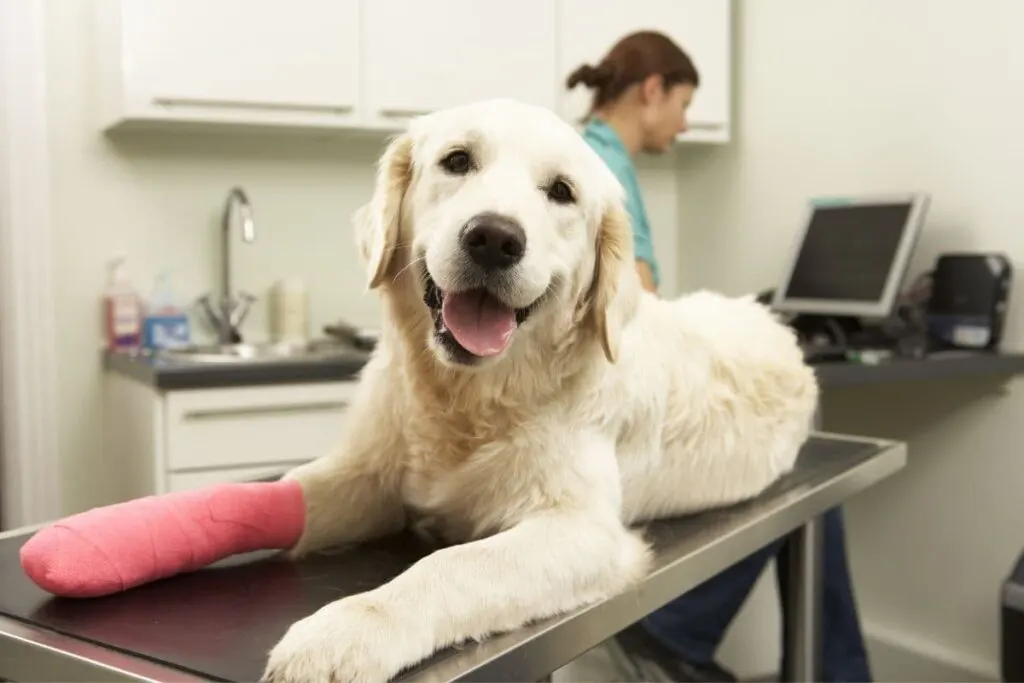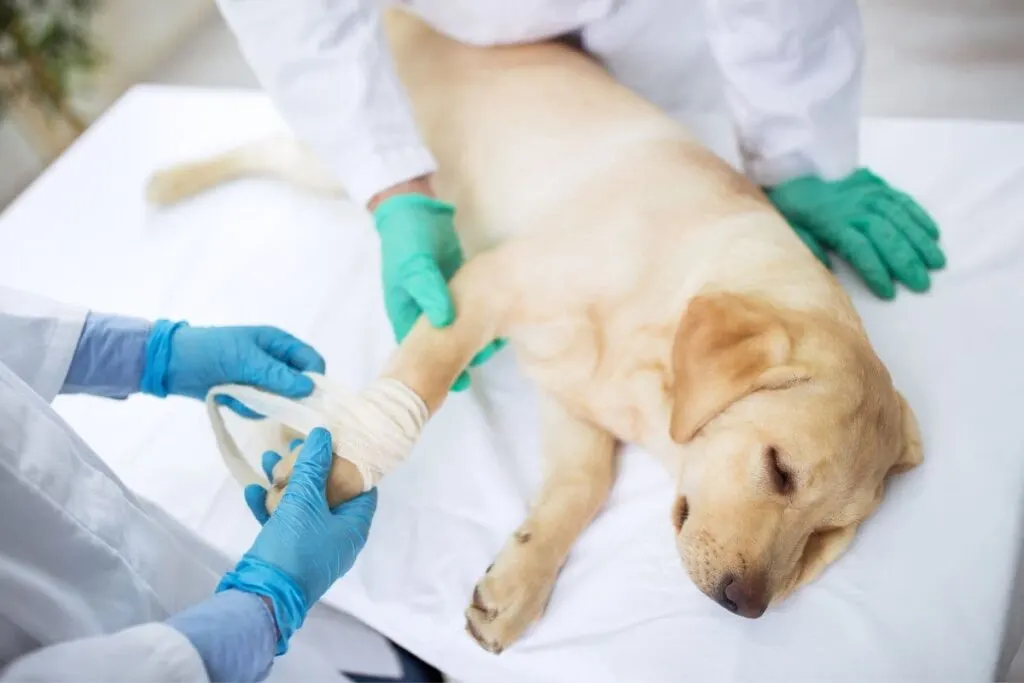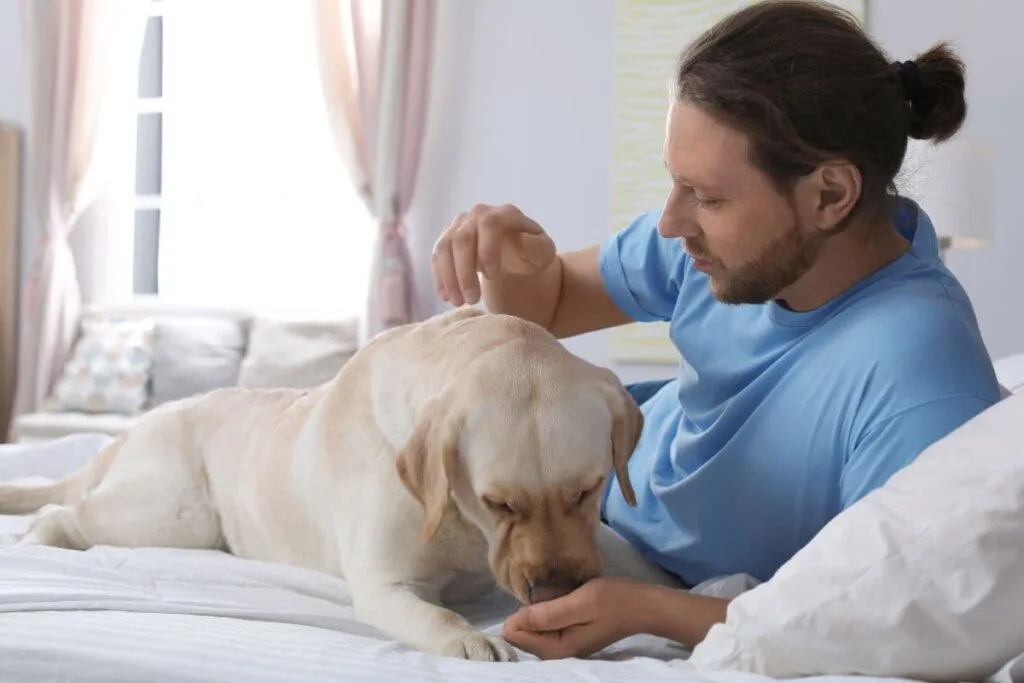You notice your dog is acting funny, limping, and it looks like it has a broken leg. Will they lay on the leg and make it worse?
A dog won’t intentionally lay on a broken leg. Like us, dogs know that lying on a broken leg may cause them more pain. However, a dog might lie on a broken leg by accident. For this reason, a dog shouldn’t move much when it has a broken leg. Treat the dog, and let it get plenty of rest.
A dog’s fractured leg must not be left untreated, so keep reading to explore how you can help your furry friend with a broken leg.

Click Here to Jump to a Section
How To Help a Dog With a Broken Leg
You’d know your dog has a broken leg if you see signs like avoiding walking (or not walking on the broken leg), swelling on the leg, yelping, and limping.
These are the typical signs, but sometimes it isn’t obvious whether your dog as a broken or facturered leg.
For example, your dog might start whining and flex its paw when you pet them to tell you it’s hurting. [Why Do Dogs Flex Their Paws When You Pet Them?]
As such, keep an eye out for strange and unusual behavior in your dogs or puppies, especially in relation to how they walk, move, or sit, to identify potential problems.
And if you do think that your canine friend has a broken leg, here are some things you can do to help them:
Take Your Dog to the Vet
The first step to helping your dog recover from its injury is to take it to the vet.
Your veterinarian will perform an x-ray to check your dog and confirm its condition.
Don’t wait before getting your dog an appointment, as delaying your appointment will worsen your dog’s condition and put it at risk of an infection, causing it more pain.
Your vet may ask for your dog’s insurance and explain to you about your dog’s treatment.
Depending on your dog’s condition, your vet may suggest surgery or wrap your dog’s injured leg with a bandage wrap.
A dog with a bandage wrap will wear it until it recovers, typically for several weeks.
Help Transport Your Dog
Transporting your dog may be a challenge.
An injured dog may avoid walking—or even moving—so you’ll want to carry your dog (if it’s a small dog) or assist your dog in walking to the car slowly.
You can use a leash to guide your dog to the car, although carrying your dog instead would be best.
Since your dog may find difficulties in hopping into the car, you may want to help lift it up into the car.

Your dog may also need assistance when getting out of the car.
Consider asking the vet to help you with assistance if necessary.
Remember not to panic upon noticing your dog’s injury.
Stay calm because panicking may cause your dog to feel anxious and scared.
Comfort Your Dog
It’s normal to feel scared and defensive when injured; dogs do the same.
Your dog may show aggression when you try to take it to the vet.
Get your dog to wear a muzzle before transporting it to the vet to avoid getting bitten.
Talk nicely to your pooch using a comforting voice or words.
Caress your dog with love and tell it that you’re trying to help, not hurt it.
Then, slowly lift your dog and carry your dog to the car, but keep in mind that you may want help carrying it to the car if it’s a big dog.
A dog with a broken leg can still walk with three legs, but it’ll need help.
As mentioned earlier, you can use a leash to guide it to the car.
At the vet, you can continue to use a soothing voice to comfort your dog.
Make Sure Your Dog Gets a Lot of Rest
Your vet may give your dog something like nonsteroidal anti-inflammatory drugs (NSAIDs) to cope with pain.
The healing process may take several weeks.
During this time, your dog mustn’t walk or lay on its broken leg.
Typically, a dog won’t walk on an injured leg, so neither will it lay on a broken leg, but it can lay on it by accident.
Your vet will tell you what to do, so follow your vet’s instructions on how to care for your dog at home.
You might want to keep your pooch in a room where its movement is limited.
Surely, an injured dog won’t move much, but as it’s recovering and feeling better, it may try to move more despite the injury not fully healed just yet.
You can get a dog playpen if you don’t have a small room for your pooch to rest.
Place the playpen in the living room where your dog can see you and other family members.
That way, your dog won’t feel lonely.
The playpen also prevents your other pets (if any) from bothering your pooch while it rests.
Note: This may not be an option for larger dogs, as they may still try to jump over the playpen despite their broken leg.
Help Your Dog Around Your House
With proper training, your dog is quite independent, but not when it’s injured.
Peeing and pooping can be challenging during the healing process, so you’ll want to help your dog go to the bathroom.
You can take your dog to the backyard or a designated area to relieve itself.

Since your dog shouldn’t move too much, you may want to reduce its food portion.
Of course, your vet will advise you on this.
The reason for giving your dog less food (such as treats) during the healing process is that your dog won’t be able to exercise as usual, like running, jumping, or walking at the park.
The inactivity can lead to your dog gaining weight quickly.
Also, ensure the wounded leg is well protected and ensure it’s safe from further impact or damage.
For instance, if you have other dogs or kids in your home, and if they accidentally step on the broken paw, it can cause a great deal of pain, delay the healing process, and even introduce more damage. [What Happens if You Step on Your Dog’s Paw?]
As such, it’s recommended to create a safe place – like a crate – in your home where your dog can rest unbothered as it heals the broken leg.
Final Thoughts
No dog owners want to see their beloved pooches in pain, but a fracture can happen, especially among highly active dogs.
Upon noticing your dog’s broken leg, call your vet immediately for an appointment.
Your vet needs to perform an x-ray to determine the severity of your dog’s condition.
After examining your dog’s leg, your vet can advise you on what to do next.
A broken leg will make your dog uncomfortable.
While it may avoid laying on the injured leg, it could accidentally lie on it.
Ensure your dog doesn’t move much during the recovery period.
